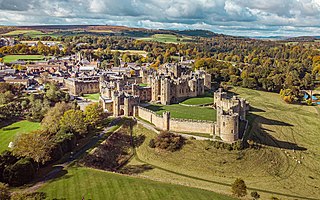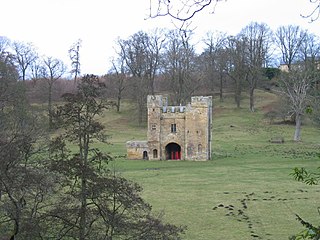
Alnwick Castle is a castle and country house in Alnwick in the English county of Northumberland. It is the seat of the 12th Duke of Northumberland, built following the Norman conquest and renovated and remodelled a number of times. It is a Grade I listed building now the home of Ralph Percy, 12th Duke of Northumberland and his family. In 2016, the castle received over 600,000 visitors per year when combined with adjacent attraction the Alnwick Garden.

The title of Earl of Northumberland has been created several times in the Peerage of England and of Great Britain, succeeding the title Earl of Northumbria. Its most famous holders are the House of Percy, who were the most powerful noble family in Northern England for much of the Middle Ages. The heirs of the Percys, via a female line, were ultimately made Duke of Northumberland in 1766, and continue to hold the earldom as a subsidiary title.

The House of Percy is an English noble family. They were among the most powerful noble families in Northern England for much of the Middle Ages. The noble family is known for its long rivalry with the House of Neville, another family powerful in northern England during the 15th century. The Percy-Neville feud provoked the War of the Roses, at the time known as the Civil Wars, in England.

Alnwick Abbey was founded as a Premonstratensian monastery in 1147 by Eustace fitz John near Alnwick, England, as a daughter house of Newhouse Abbey in Lincolnshire. It was dissolved in 1535, refounded in 1536 and finally suppressed in 1539. The Alnwick Abbey site is located just within Hulne Park, on the bank of the River Aln. The only visible remnant is the impressive 14th-century gatehouse, a Grade I listed building.

Eustace de Vesci (1169–1216) was an English lord of Alnwick Castle, and a Magna Carta surety. He also held lands in Sprouston, Roxburghshire, Scotland as brother in-law to King Alexander II of Scotland. Eustace was a leader during the Barons' War in 1215 and was killed while undertaking a siege of Barnard Castle in 1216.
John FitzThomas was an Anglo-Norman in the Peerage of Ireland, as 4th Lord of Offaly from 1287 and subsequently as 1st Earl of Kildare from 1316.

Henry de Percy, 1st Baron Percy of Alnwick was a medieval English magnate.

Hugh de Balliol, Lord of Bywell, Barnard Castle and Gainford, was an English nobleman. He was the son of Eustace de Balliol and Petronilla FitzPiers. Balliol was a supporter of King John of England during the Barons Wars of 1215–17.
Eustace fitz John, Constable of Chester, was a powerful magnate in northern England during the reigns of Henry I, Stephen and Henry II. From a relatively humble background in South East England, Eustace made his career serving Henry I, and was elevated by the king through marriage and office into one of the most important figures in the north of England. Eustace acquired a great deal of property in the region, controlled Bamburgh Castle, and served jointly with Walter Espec as justiciar of the North.
William de Vesci (c.1125–1184) was an Anglo-Norman feudal lord and Sheriff. Born William fitz Eustace at Knaresborough Castle, Yorkshire, the son of Eustace Fitz John and Beatrix de Vesci, he took his mother's surname.

John de Vesci, sometimes spelt Vescy, was a prominent 13th-century noble. He was the eldest son of William de Vesci and Agnes de Ferrers. He married firstly Agnes de Saluzzo and secondly Isabella de Beaumont. John died c. 1289.

William de Vesci or Vescy was a prominent 13th-century noble. He was a son of William de Vesci and his second wife Lady Agnes de Ferrers, daughter of William de Ferrers, 5th Earl of Derby, and his first wife Sibyl Marshal.

William de Vescy, sometimes spelt Vesci, Baron de Vesci, was an illegitimate child of William de Vesci and Devorgille, daughter of Donal Roe Macarthy Mor, Prince of Desmond. He was born in Kildare, Ireland. As he was illegitimate, he had no right to inherit any of his father's properties. In anticipation of this, his father had therefore entered into a number of covenants with Antony Bek, Bishop of Durham designed to enable his son to acquire the properties through entail. Early in Edward I's reign, William asked the king to intervene to enforce the implementation of these covenants.
William de Vesci was the son of Eustace fitz John, who died in 1184.
William de Vesci or Vescy was a prominent 13th-century English noble. He was a son of Eustace de Vesci and Margaret, an illegitimate daughter of William the Lion by a daughter of Adam de Hythus.
Ivo de Vesci, sometimes spelt Vescy and first name sometimes Yves, was a prominent 11th-century English noble. He obtained lands and the lordship of Alnwick in Northumberland from King William II of England. He was also given lands in Malton, Yorkshire. It is not known whether he is the son or kinsman of the Robert de Veci who participated in the Norman conquest of England and was rewarded with great estates in the counties of Northampton, Warwick and Lincoln.

Beatrix de Vesci of Alnwick Castle, was an eleventh-century medieval noble lady of house de Vesci.

Sir Gilbert de Aton, 1st Baron Aton, of Ayton, Langdon, Malton and Wintringham, Yorkshire was a 13th-14th century English noble. He died c. 1342.
Baron Vesci was a title in the Peerage of England and Peerage of the United Kingdom. It existed as a feudal barony by tenure, before being created by Writ of summons to Parliament of John de Vesci in 1264 until his death in 1289. It was created a second time by writ of William de Vescy in 1295 until his death in 1297. It was created a third time in 1313 by writ of William de Vesci until his death in 1314. The title was created a fourth time by writ of Henry Bromflete, Lord Vescy in 1449 until it became extinct in 1469 upon his death. The title was created a fifth time for John Vesey, 4th Viscount de Vesci in 1884 until his death in 1903 when the title became extinct.

The Constable of Chester was a mediaeval hereditary office held by the Barons of Halton. The functions of the Constable are unclear, possibly they related to the custody of Chester Castle, as was the main function of most mediaeval constables, but Sanders (1960) says the office-holder was constable for the entire County Palatine.













